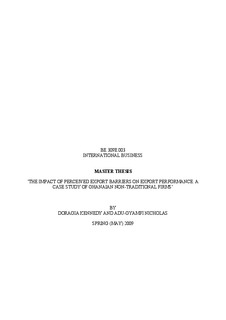The impact of perceived export barriers on export performance : a case study of Ghanaian non-traditional firms
Abstract
Over the years there have been substantive studies albeit contradictory findings on the relationship
between perceived export barriers and export performance (Madsen, 1987; Zou and Stan, 1998;
Aaby and Slater, 1989), on firms of different sizes and resources across a wide variety of
industries. In spite of the increasing research on export performance in business studies, the major
focus has mainly been on studies within the scope of western market context. There have been
relatively few studies done with respect to this in a developing market context such as sub-Saharan
Africa and particularly Ghana. This literary gap has been the main motivation for this thesis.
We reviewed prior literature and conducted a survey of 100 Ghanaian non-traditional export
firms. Our findings supported our main hypothesis that there is a negative relationship between
perceived export barriers and export performance. Other findings support the hypothesis that
internal management forces and firm size had a negative relationship with perceived export
barriers. However, two of our hypotheses that firm internationalization had a negative relationship
with perceived export barriers and that firm commitment had a positive relationship with export
performance were not support
Findings from this study adds up to prior literature by isolating for discussion variables which
contribute to the improvement of both perceived export barriers and export performance measures
in a sub-Saharan African country context.
Some of the noted limitations during our study include the following; first, scanty research work on
problems pertaining to exporting firms from developing countries served as a major limitation of
our work. The lack of research on the subject with particular reference to developing country
context indicates the lack of theories and methodologies developed specifically for the context of a
sub-Saharan African country. Findings from this study can be adapted to serve as a guide in the
development of a questionnaire for a survey of small and medium scale exporters from other
developing countries. This research work may also serves as an important guide for future
researchers who intend to study export problems in other developing countries. Moreover, policy
makers in developing countries can use this work to identify export problems that firms face in
order to provide timely and effective assistance to small and medium scale enterprises engaged in
export ventures.
Description
Mastergradsoppgave i bedriftsøkonomi - Høgskolen i Bodø, 2009
